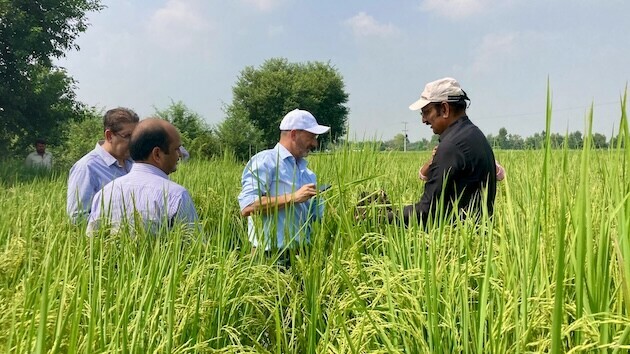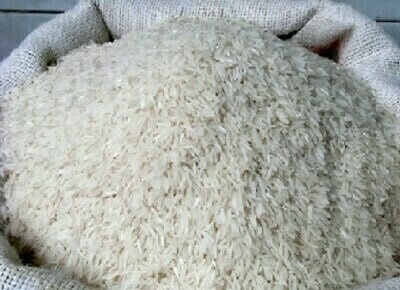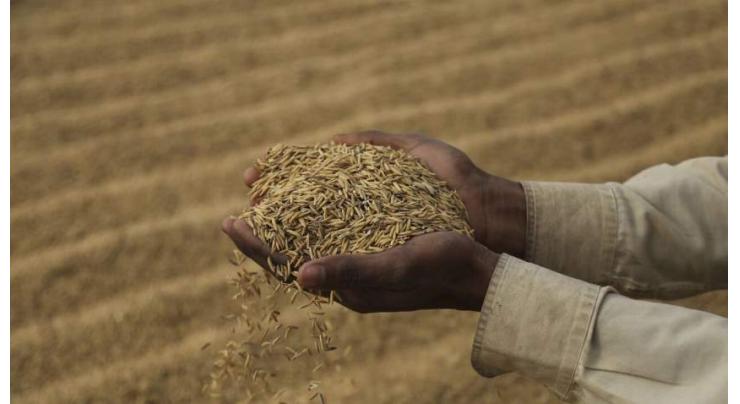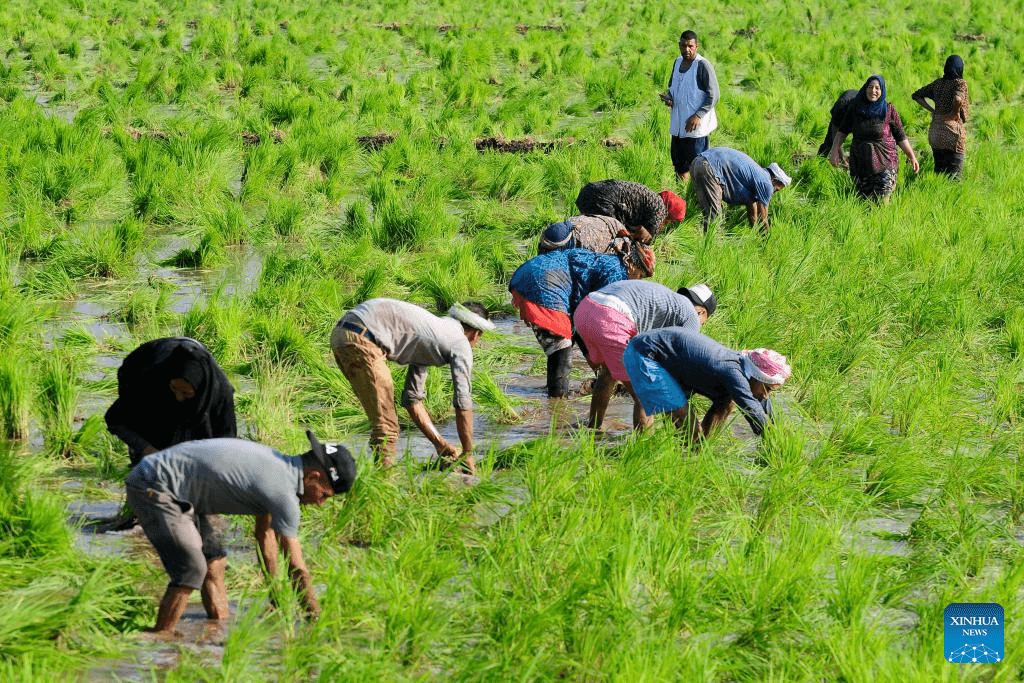Tags
Why farmers in India and Pakistan are shifting to ‘regenerative’ farming
The technique is seen as a climate solution, with advocates saying it is the most straightforward way to benefit the planet’s health and ensure food security.
Nine years ago, farmer Sultan Ahmed Bhatti gave up tilling the soil and using most fertilisers and pesticides on his farm in Doober Bhattian, Pakistan.
His brothers at first derided him. But soon, his first experiment with growing wheat on raised beds was a runaway success. “We produced more wheat than what we grew on ploughed, flat land,” he said.

Sultan Ahmed Bhatti discussing his farming techniques with visitors. Photo credit: Sukheki farms of Sultan Ahmed Bhatti
Today, researchers, climate experts, and agriculture students visit his 100-acre farm, where he grows wheat, rice, maize, sugarcane, and vegetables, to see how he is able to reap bumper crops with minimal input costs.
The magic is in the soil, says Bhatti, picking up a fistful of soil in his calloused hand. “It’s all about respecting the soil that treats you so well.”
Bhatti is among a small but growing segment of farmers across Pakistan and India pursuing “regenerative” farming techniques. It’s part of a global movement to make agriculture more sustainable by increasing soil health through cutting back on chemicals, adding organic material to soil, and diversifying plants and animals on the farm.
Experts see regenerative farming as a climate solution

“Changing agricultural practices is the most straightforward way to benefit the planet’s health while ensuring food security in the long term,” said Francesco Carnevale Zampaolo, programme director at SRI-2030, a UK-based global organisation that promotes eco-friendly farming to reduce greenhouse gas emissions and enhance carbon sequestration.
Bio-agriculture scientist Dr Farooq-e-Azam, based in Faisalabad, Pakistan, has been promoting these methods since the early 1970s. He thinks that regenerative agriculture might be the key to addressing food insecurity and reducing intensive farming’s role in causing human-induced land degradation.
But there is no one-size-fits-all formula for transitioning to regenerative agriculture. It may require a different set of farming approaches depending on the soil type, weather conditions, and biodiversity. But generally, it means applying a range of techniques to restore the soil’s health.
These techniques include adding crop residue, composted manure, and natural rock minerals, says Azam, director of the Research and Development unit at US-based Bontera BioAg.

Indian farmers turning to nature for solutions
The same is happening across the border, in India, too, where more farmers are shifting to a natural way of farming.
More than two decades ago, Samir Bordoloi quit his government job to become a farmer. Now, Bordoloi cultivates crops such as turmeric, jackfruit, papaya, and king chilies on nearly 12 acres of land in Sonapur, about 30km from Guwahati, a city in northeast India. The once-derelict ground that Bordoloi took on lease is a flourishing food forest today.
Bordoloi uses zero tillage and no pesticides or chemical fertilisers. Among other innovative techniques, Bordoloi scatters “seed bombs” on his land and lets them germinate naturally. For example, he plucks uniform sized ripened chillies and keeps them aside for seven days.
“Then we slice and take out their seeds and cover them with a mixture made of biochar, cow dung, and bamboo, which is then shaped into a ball.”
Is conventional farming sustainable?
Conventional farming in India and Pakistan has taken a toll on agricultural land. Around 30 per cent of the land in India is degraded, according to the National Bureau of Soil Survey and Land Use Planning. More than 50pc of India’s farmers are debt-ridden, according to the 2019 National Statistical Office, and often seek alternatives outside of agriculture, or tragically, take their own lives.
In Pakistan, almost three-fourths of the land is degraded, according to Pakistan’s climate change ministry.
“Droughts, floods, deforestation, overgrazing, monoculture farming, excessive tillage, and the use of chemical fertilisers and pesticides are the most glaring causes of land degradation on both sides of the fence,” said Dr Aamer Irshad, head of programme at the Food and Agriculture Organisation of the United Nations, in Pakistan.
Dr Vinod K. Chaudhary, an associate professor of sociology at Punjab University in Chandigarh, India, who is also a farmer, said farming methods in both countries are unsustainable.
While researching sustainable farming, he came across videos on YouTube and Facebook put up by Asif Sharif, a progressive farmer from Pakpattan, across the border in Pakistan’s Punjab province. “I learned plants require moisture, not water, which was the most difficult to believe, as we farmers believe in inundation.”
He also learned that soil should be covered, not tilled. Chaudhary decided to try Sharif’s techniques and found they worked well. Now he encourages farmers in Indian Punjab and Haryana to try them.
“The soil resets itself with this kind of farming,” Chaudhary said.
Experimenting and finding solutions
Regenerative farmers are experimenting and spreading the word.
Mahmood Nawaz Shah, a third-generation progressive farmer with 600 acres of farmland in Tando Allah Yar district of Sindh province, Pakistan, has adopted regenerative agricultural techniques “through hit and trial and finding solutions” now for 25 years.
Shah controls fruit flies on his 45-acre mango orchards through pheromone traps and lets parasites that eat borers loose in the sugarcane field.
“This allows us to delay pesticide sprays as late as possible as well as increase the intervals between two sprays,” he explains.
Shah also uses farmyard manure from livestock, grows peas, cauliflower, and black cumin amid 145 acres of sugarcane crop, and adds mineral-rich silt to his land.
“It has all been a gradual and experimental process,” he says.
Dhaniram Chetia, a farmer in the village of Pengeri in Tinsukia, in India’s Assam state, found an innovative way to keep insects off his harvest: He grows papaya, tomatoes, and bananas on 30pc of his eight acres of land to feed the local birds.
“The birds eat the pests that would otherwise prey on my cash crops. I don’t need to use insecticides,” he says.
Bordoloi in Assam says elephants have helped in turmeric farming.
“Elephants stamp on our turmeric plants, cut out the thatch and consume the green elephant grass after the rains; we barely need any labour,” he added.


Does regenerative agriculture live up to the hype?
It’s hard to find definitive data on regenerative agriculture. Organic farming data may come closest. India has up to 2.66 million hectares of agricultural land under organic farming, according to the The World of Organic Agriculture 2023 yearbook, which places India among “countries with the most organic producers” alongside Uganda and Ethiopia. However, the data given by India’s department of agriculture and farmers welfare puts natural farming at just 0.65m hectares.
In Pakistan, the area under naturally organic agriculture in the country is about 1.51m hectares, or about 6pc of all agricultural land, according to the Pakistan Organic Association (POA), while land certified to be cultivated organically is just 64,885 hectares. “The government has not realised the virtues of this kind of farming and there is a complete absence of government policies and practices, particularly for organic food regulations and certification,” pointed out Dr Hasan Ali Mughal, founder of POA.
Further, 10pc of the landlords in Pakistan own 52pc of the land, where they prefer to carry out mono-cropping of wheat and rice, said the FAO spokesperson, Irshad. He predicted that regenerative agriculture “cannot become mainstream in Pakistan” due to poor soil conditions.
But soil revival using solutions from nature takes time, says Mohammad Zaman, 47, a farmer from Tando Jan Mohammad of Pakistan’s Sindh province’s Mirpurkhas district. He met with some initial resistance from his father when he decided to adopt a more “natural” way of farming on their 30 acres of mango orchards in 2017. But he has, so far, spared his 400 or so mango trees from all kinds of insecticides, fungicides, and pesticides. “I sell online and I’ve realised there is a growing demand for chemical-free fruits among consumers,” he said.
Seven years later, he is most satisfied. “I could not have chosen a better path for farming,” he said, as the soil fertility is even better than when his father was farming. He also grows ber, or Indian jujube, following the same principles.
“My water application is reduced by 50pc as the dead and live mulch cover keeps the land moist,” said Zaman, who also grows sugarcane and bananas. “We broke the myth that sugarcane and bananas are water guzzlers,” he said. He, however, uses fertiliser on the banana crop “sparingly” but intends to wean it off in two years.
This was endorsed by Indira Singh, lead at the School for Environment and Sustainability at the Indian Institute for Human Settlement (IIHS), in Bengaluru.
“Getting soil rejuvenation may take a little more time, but eventually, as the soil microbiomes bloom, they will see change, which will lead to a sustainable solution,” she said.

Looking for larger solutions


Some would like to see more government support for regenerative farming.
Shah, currently the president of the Sindh Abadgar Board, an organisation of agriculturists in Sindh, said farmers are not being prepared for adapting to climate change and are not provided with solutions to counter those challenges.
Islamabad-based Dr M. Azeem Khan, former chairman of the Pakistan Agriculture Research Council, agreed. The governments, he said, will need to modify existing farm equipment, build new ones, and make them available, as most small farmers cannot afford them. Further, the state will need to build the technical capacity of its extension workers, who can not only convince but also train farmers to give up their “old ways” and to let nature take its course.
“Seeing is believing; only then will farmers accept change,” Khan said.
Khan said cheaper electricity, like solar, surety to procure produce, provision of timely and subsidised inputs, repair and maintenance of farm machinery, and an effective advocacy system focusing on how to move towards regenerative and environment-friendly agricultural practices would help.
“At the outset, the change may be costly,” but it is possible, he said.
This article was originally published as a part of a cross-border reporting workshop organised by the US-based East-West Center on Inter Press Service and has been reproduced with permission.
Header image: Farmer Samir Bordoloi showing a tea bud as he stands amidst his tea shrubs. He cultivates various crops such as turmeric, jackfruit, papaya and king chilies on nearly 12 acres of land. Bordoloi calls himself a “compassionate farmer”, and believes in zero tillage, no pesticides and chemical fertilisers. Photo credit: Sanskrita Bharadwaj/IPS
https://www.dawn.com/news/1824460/why-farmers-in-india-and-pakistan-are-shifting-to-regenerative-farmingPublished Date: April 5, 2024






